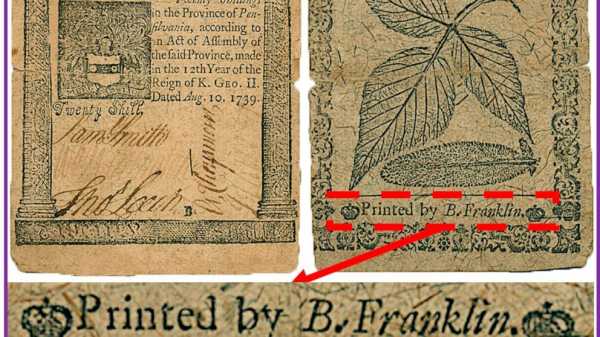
SAN FRANCISCO — Benjamin Franklin was so busy as an inventor, publisher, diplomat and U.S. founding father that it’s easy to lose track of his accomplishments.
Add one more to the roster: his early work in printing colonial paper currency designed to counter a constant threat of counterfeiting.
Franklin was an early innovator of printing techniques that used colored threads, watermarks and imprints of natural objects such as leaves to make it far harder for others to create knockoffs of the paper bills he printed. A team at Notre Dame University has shed new light on his methods via advanced scanning techniques that reveal some of Franklin’s methods in greater detail — along the way, also providing one more reason Franklin appears on the $100 bill.
The new research, published Monday in the Proceedings of the National Academy of Sciences, describes data gathered with techniques such as spectroscopy, which uses laser light to identify particular elements in test samples, and electron microscopy for imaging fine details. The intent, said lead author Khachatur Manukyan, a Notre Dame associate professor of physics, was to learn more about the materials used by Franklin and his network of affiliated printers and how they served to distinguish their bills from cheaper knockoffs.
The work examined Franklin's penchant for including watermarks, tiny indigo-dyed threads and “fillers” of special crystal in printed bills to create barriers to copycats. It also highlighted Franklin's use of “nature printing,” a technique by which he transferred the detailed vein patterns of tree leaves to printing plates.
These techniques raised numerous barriers to would-be copycats. Counterfeiters naturally sought to keep their costs low, and thus were loath to invest in improving their own printing techniques. Franklin's fillers served to make bills hardier and thus extend their life considerably over the cheaper paper preferred by criminals, while his indigo-dyed threads added another production barrier.
Similarly, Franklin's nature-printed images involved such detail that it was particularly difficult for less skilled printers to duplicate.
The Revolutionary War, however, brought on such a surge of counterfeiting — much of it provided by the British army — that the new United States government shunned paper bills in favor of coinage for decades. It didn't reconsider until the onset of the Civil War in 1861, when the federal government first authorized the printing of dollar bills called “greenbacks.”
Colored threads were later included in the U.S. banknotes printed a century later.
Sourse: abcnews.go.com






